In the previous article, we introduced the implementation of RPC basic services. Now we will go on to how to make an RPC service into a standard product and what needs to be implemented.
It is not enough for our service consumers to only realize remote invocation, which is still a long way from commercialization.
The core functions of Consumer include:
- Connection management
- load balancing
- Request routing
- timeout handler
- health examination
The core functions of the Provider include:
- Queue / thread pool
- Timeout discard
- Elegant close
- overload protection
1, Design and implementation of RPC service consumer core functions
1. Connection management
First, let's analyze the connection management function design of consumer.
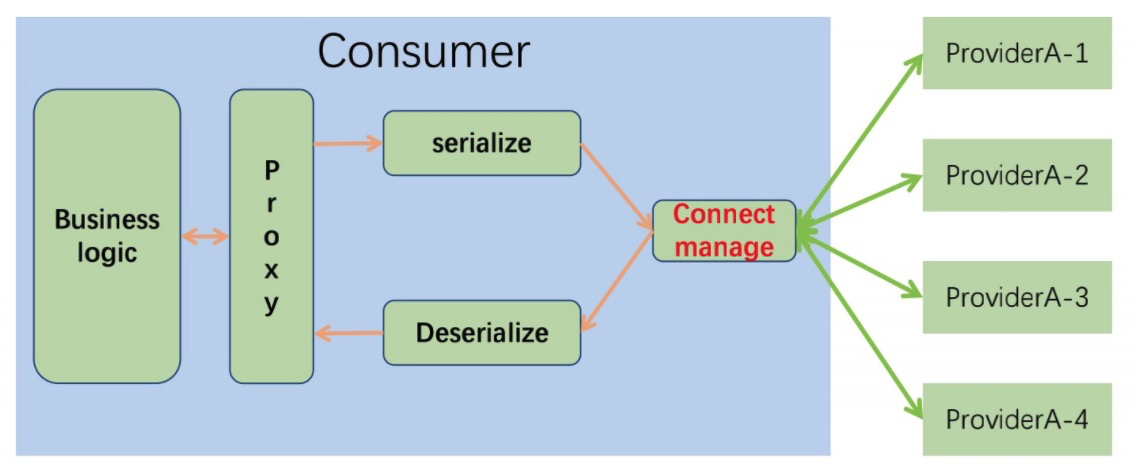
The business logic initiates a remote call service, calls it through the proxy, first serializes it, then finds the connection, sends the request, and receives the result.
The consumer needs to maintain a long connection with the service provider to transmit the request data and return the result.
Connection management includes the following function points:
- Initialization timing: when to create a connection, different modules have different requirements.
- Gateway: the gateway needs to connect many modules. Some modules may have few requests. If they can be created in advance, there may be a waste of resources. Therefore, it is better for the gateway to adopt the lazy loading method, and create a connection with the corresponding module when calling the service
- Business services can be created in advance
- Connection number maintenance
- Heartbeat / reconnection
2. Load balancing
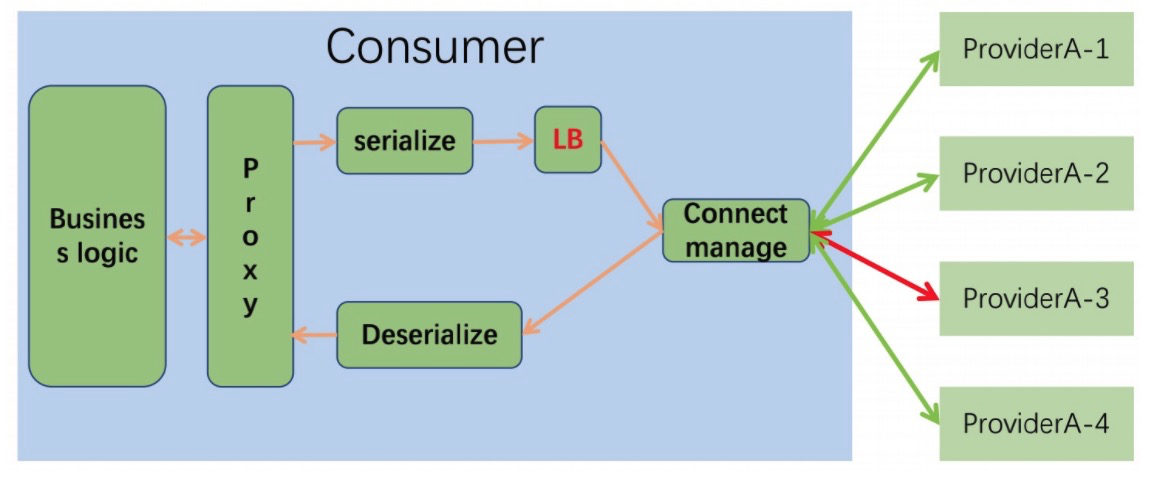
Load balancing needs to ensure that the traffic of multiple service provider nodes is uniform / reasonable, and support node expansion and gray-scale publishing.
There are many load balancing algorithms
- polling
- random
- Take mold
- Weighted
- Consistency Hash
We all know about polling, randomization and module taking. We won't talk about it here. We'll mainly talk about the weighted algorithm.
(1) Weighted load balancing design
- Value within the weight range of 0 ~ 10
- A higher value means a higher weight
- The higher the weight, the greater the proportion of allocated traffic

Algorithm design:
data structure
- Array, filled according to weight values
- The positions of 0 and 1 are randomly disrupted
Algorithm description
- Load balancing selects a node
- Generate random numbers between 0 and 9, or choose an array?
- Corresponding value: 0 uses this node, 1 does not use this node
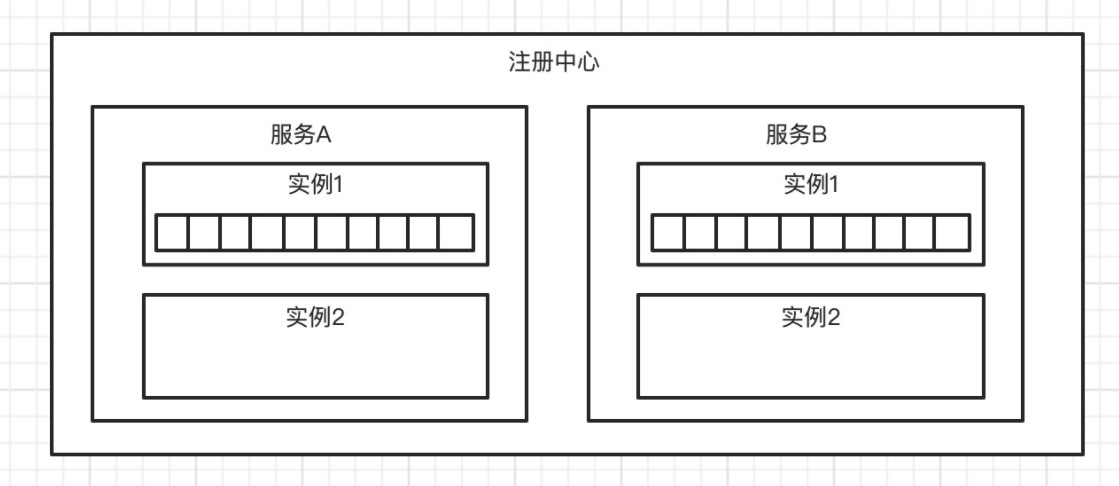
Creation of weight array:
// num indicates the number of 1 in the generated array. In the array, 1 indicates discarding the request and 0 indicates accepting the request
public static byte[] randomGenerator(int limit, int num) {
byte[] tempArray = new byte[limit];
if (num <= 0) {
for (int i = 0; i < limit; i++) {
tempArray[i] = 0;
}
return tempArray;
}
if (num >= limit) {
for (int i = 0; i < limit; i++) {
tempArray[i] = 1;
}
return tempArray;
}
//Randomly fill the array with num 1s
Random random = new Random();
for (int i = 0; i < num; i++) {
int temp = Math.abs(random.nextInt()) % limit;
while (tempArray[temp] == 1) {
temp = Math.abs(random.nextInt()) % limit;
}
tempArray[temp] = 1;
}
return tempArray;
}
(2) Implementation of polling + weight load balancing
- Polling to a server node
- Then filter again according to the weight
- Poll to next node
for (int i = start; i < start + count; i++) {
int index = i % count;
Server server = servers.get(index);
if (needChooseAnotherOne.test(server)) {
requestCount.getAndIncrement();
continue;
}
int requestTime = this.getRequestTimeCountAndSet(server, count);
if (server.getWeights() <10 && server.getWeights() > -1) {
byte[] abandonArray = server.getAbandonArray();
// abandonTimes[i] == 1 indicates that the server does not accept the request
if (abandonArray[requestTime % abandonArray.length] == 1) {
requestCount.getAndIncrement();
continue;
}
}
if (serverState.NORMAL == server.getState()) {
result = server;
break;
}
requestCount.getAndIncrement();
}
(3) Request routing
The function of request routing is to filter out the list of service providing nodes that can be selected through a series of rules. It plays an important role in application isolation, read-write separation and gray-scale publishing.
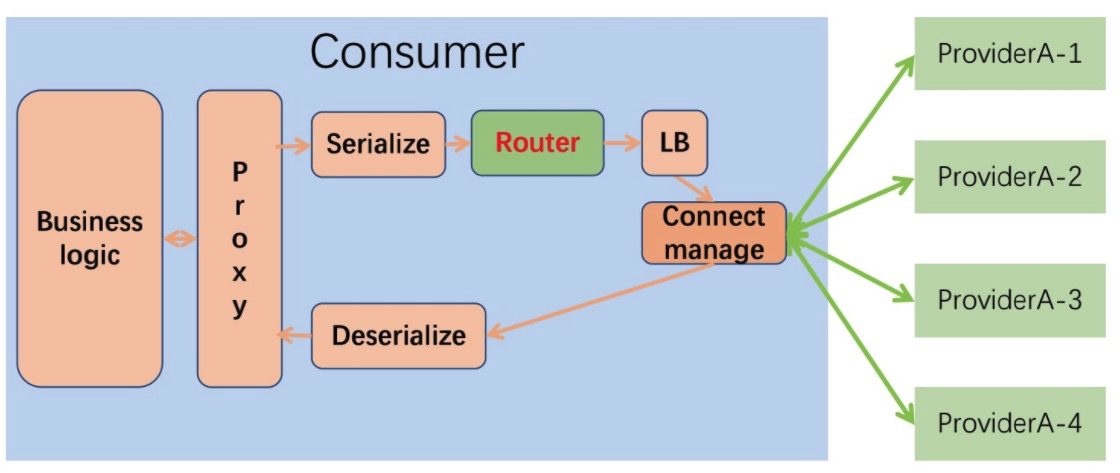
The functional design of routing includes
- Matching rules
- behavior
- Linked list
Matching rule design
- Attributes to be compared
- operator
- Attribute matching value
- Matching node
Data structure design
- Linked list
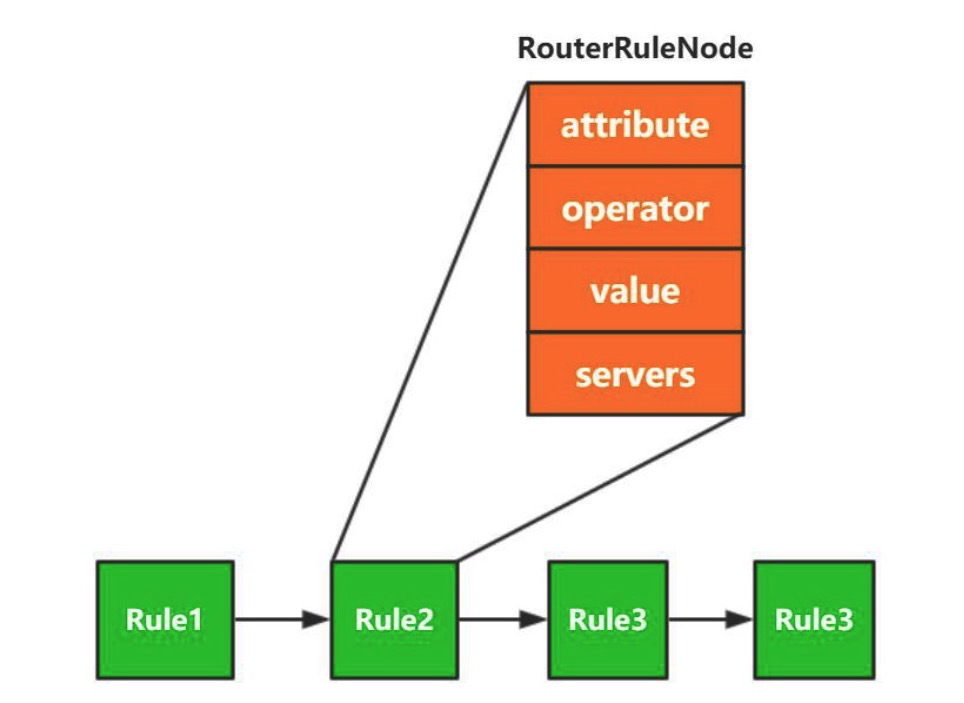
IP streaming rules: attribute=IP, operator=IN, value={IP1, IP2}, servers={Node1, Node2}

The above is a classic Routing Strategy of Dubbo. We have four service providers. Now we publish in grayscale and grayscale ProviderA-1. There are two rules in the rule chain: the first rule is that all traffic will not call ProviderA-1, so there will be no traffic to ProviderA-1; The second rule is that when gray traffic reaches ProviderA-1, other traffic is accessed normally.
(4) Timeout processing
Caller timeout processing:
- Worker thread blocking
- Waiting for packet return notification
- Timeout logic
- Worker waiting for notification
- Data return termination wait
- Timeout throw exception
- Caller timeout processing
/**Proxy class requests send and receive call logic
* 1,Register WindowData
* 2,Asynchronous transmission
* 3,Wait for data to arrive
* 4,Log out of WindowData
*/
public Protocol request(Protocol requestProtocol) throws Exception {
// Server status judgment
if (ServerState.Reboot == state || ServerState.Dead == state) {
throw new RebootException();
}
increaseCU();
CSocket socket = null;
try {
try {
socket = socketPool.getSocket();
byte[] data = requestProtocol.toBytes(socket.isRights(), socket.getDESKey()); // serialize
// Register WondowData and put it into the Map of session windowdata
socket.registerRec(requestProtocol.getSessionId());
// Send asynchronously and put the data into the sending queue
socket.send(data);
} catch (TimeoutException e) {
timeout();
throw e;
} catch (IOException e) {
if (socket == null || !socket.connecting()) {
if (testServerSocket() != ServerState.Normal) {
this.asDeath();
logger.info("this server : {} is dead , will choose another one !", address);
// logger.error(String.format("server %s is dead", new Object[]{this.address}), e);
throw new RebootException();
}
}
throw e;
} catch (Exception e) {
throw e;
} finally {
if (socket != null) {
socket.dispose();
}
}
// receive data
byte[] buffer = socket.receive(requestProtocol.getSessionId(), currUserCount);
Protocol receiveProtocol = Protocol.fromBytes(buffer, socket.isRights(), socket.getDESKey());
return receiveProtocol;
} finally {
if (socket != null) {
if (sockett != null) {
// Log out of windowsdata
socket.unregisterRec(requestProtocol.getSessionId());
}
}
}
}
// Data transmission implementation logic
// 1. Register the Map that sends the event sessionid windowdata
public void registerRec(int sessionId) {
AutoResetEvent event = new AutoResetEvent();
WindowData wd = new WindowData(event);
WaitWindows.put(sessionId, wd);
}
// 2. Asynchronous transmission
public void send(byte[] data) {
try {
if (null != transmitter) {
TiresiasClientHelper.getInstance().setEndPoint(channel);
TransmitterTask task = new TransmitterTask(this, data);
transmitter.invoke(task);
}
} catch (NotYetConnectedException ex) {
_connecting = false;
throw ex;
}
}
public void invoke(TransmitterTask task) {
int size = wqueue.size();
if (size > 1024 * 64) {
logger.warn(Version.ID + " send queue is to max size is:" + size);
}
//Put in queue and send asynchronously
wqueue.offer(task);
}
// Send thread processing logic
class SendTask implements Runnable {
@Override
public void run() {
int offset = 0;
// Cache data for aggregate sending
TransmitterTask[] elementData = new TransmitterTask[5];
int waitTime = 0;
for (;;) {
try {
TransmitterTask task = wqueue.poll(waitTime, TimeUnit.MILLISECONDS);
// There is no request data in the request queue. Send data
if (null == task) {
if (elementData.length > 0 && offset > 0) {
send(elementData, offset);
offset = 0;
arrayClear(elementData);
}
waitTime = 10;
continue;
}
// Array full, send data
if (offset == 5) {
// send out
if (null != elementData) {
send(elementData, offset);
}
offset = 0;
arrayClear(elementData);
}
// It is not sent in real time and is temporarily put into the array
elementData[offset] = task;
waitTime = 0;
++offset;
} catch (Exception ex) {
offset = 0;
arrayClear(elementData);
ex.printStackTrace();
} catch (Throwable e) {
e.printStackTrace();
}
}
}
}
// Worker thread receiving data processing logic
public byte[] receive(int sessionId, int queueLen) {
// Get WindowData
WindowData wd = WaitWindons.get(sessionId);
if (wd == null) {
throw new RuntimeException("Need invoke 'registerRec' method before invoke 'receive' method!");
}
AutoResetEvent event = wd.getEvent();
// Wait for data to arrive event
if (!event.waitOne(socketConfig.getReceiveTimeout())) {
throw new TimeoutException("ServiceIP:[" + this.getServiceIP() + "],Receive data timeout or error!timeout:" + socketConfig.getReceiveTimeout() + "ms,queue length:"
+ queueLen);
}
// Get Data from WindowData
byte[] data = wd.getData();
int offset = SFPStruct.Version;
int len = ByteConverter.bytesToIntLitterEndian(data, offset);
if (len != data.length) {
throw new ProtocolException("The data length inconsistent!datalen:" + data.length + ",check len:" + len);
}
return data;
}
// AutoResetEvent implementation
public class AutoResetEvent {
CountDownLatch cdl;
public AutoResetEvent() {
cdl = new CountDownLatch(1);
}
public AutoResetEvent(int waitCount) {
cdl = new CountDownLatch(waitCount);
}
public void set() {
cdl.countDown();
}
public boolean waitOne(long time) {
try {
return cdl.await(time, TimeUnit.MILLISECONDS);
} catch (Exception e) {
throw new RuntimeException(e);
}
}
}
// Receive thread processing logic
public void decode(ByteBuffer receiveBuffer, byte[] receiveArray) throws Exception {
try {
int limit = receiveBuffer.limit();
int num = 0;
for (; num < limit; num++) {
byte b = receiveArray[num];
receiveData.write(b);
if (b == ProtocolConst.P_END_TAG[index]) {
index++;
if (index == ProtocolConst.P_END_TAG.length) {
byte[] pak = receiveData.toByteArray(ProtocolConst.P_START_TAG.length, receiveData.size() - ProtocolConst.P_END_TAG.length - ProtocolConst.P_START_TAG.length);
// Resolve the SessionId in the returned package
int pSessionId = ByteConverter.bytesToIntLittleEndian(pak, SFPStruct.Version + SFPStruct.TotalLen);
// Obtain the corresponding windowsdata according to the sessionId
WindowData wd = WaitWindows.get(pSessionId);
if (wd != null) {
if (wd.getFlag() == 0) {
// Put the returned data into WindowData
wd.setData(pak);
// Call countDown of CountDownlatch to end the waiting of the worker thread
wd.getEvent().set();
} else if (wd.getFlag() == 1) {
// asynchronous
if (null != unregisterRec(pSessionId)) {
wd.getReceiveHandler().notify(pak, wd.getInvokeCnxn());
}
} else if (wd.getFlag() == 2) {
// asynchronous
logger.info("unsupport request type");
}
}
index = 0;
receiveData.reset();
continue;
}
} else if (index != 0) {
if (b == ProtocolConst.P_END_TAG[0]) {
index = 1;
} else {
index = 0;
}
}
}
} catch (Exception e) {
index = 0;
ex.printStackTrace();
receiveData.clear()
}
}